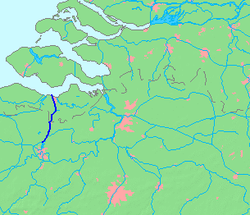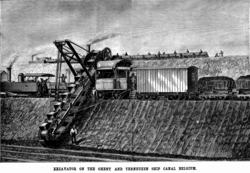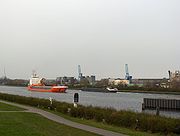
Ghent-Terneuzen Canal
Encyclopedia

Canal
Canals are man-made channels for water. There are two types of canal:#Waterways: navigable transportation canals used for carrying ships and boats shipping goods and conveying people, further subdivided into two kinds:...
linking Ghent
Ghent
Ghent is a city and a municipality located in the Flemish region of Belgium. It is the capital and biggest city of the East Flanders province. The city started as a settlement at the confluence of the Rivers Scheldt and Lys and in the Middle Ages became one of the largest and richest cities of...
in Belgium
Belgium
Belgium , officially the Kingdom of Belgium, is a federal state in Western Europe. It is a founding member of the European Union and hosts the EU's headquarters, and those of several other major international organisations such as NATO.Belgium is also a member of, or affiliated to, many...
to the port
Port
A port is a location on a coast or shore containing one or more harbors where ships can dock and transfer people or cargo to or from land....
of Terneuzen
Terneuzen
Terneuzen is a city and municipality in the southwestern Netherlands, in the province of Zeeland, in the middle of Zeelandic Flanders. With over 55,000 inhabitants, it is the most populous municipality of Zeeland.-Population centres :...
on the Westerschelde (Scheldt
Scheldt
The Scheldt is a 350 km long river in northern France, western Belgium and the southwestern part of the Netherlands...
) estuary
Estuary
An estuary is a partly enclosed coastal body of water with one or more rivers or streams flowing into it, and with a free connection to the open sea....
in the Netherlands
Netherlands
The Netherlands is a constituent country of the Kingdom of the Netherlands, located mainly in North-West Europe and with several islands in the Caribbean. Mainland Netherlands borders the North Sea to the north and west, Belgium to the south, and Germany to the east, and shares maritime borders...
, thereby providing the former with better access to the sea
Sea
A sea generally refers to a large body of salt water, but the term is used in other contexts as well. Most commonly, it means a large expanse of saline water connected with an ocean, and is commonly used as a synonym for ocean...
.

History
The canal was constructed between 1823 and 1827 on the initiative of the Dutch KingWilliam I of the Netherlands
William I Frederick, born Willem Frederik Prins van Oranje-Nassau , was a Prince of Orange and the first King of the Netherlands and Grand Duke of Luxembourg....
: Belgium (as it subsequently became) and the Netherlands had become a united country
United Kingdom of the Netherlands
United Kingdom of the Netherlands is the unofficial name used to refer to Kingdom of the Netherlands during the period after it was first created from part of the First French Empire and before the new kingdom of Belgium split out in 1830...
under the terms agreed at the Congress of Vienna
Congress of Vienna
The Congress of Vienna was a conference of ambassadors of European states chaired by Klemens Wenzel von Metternich, and held in Vienna from September, 1814 to June, 1815. The objective of the Congress was to settle the many issues arising from the French Revolutionary Wars, the Napoleonic Wars,...
. After Belgium broke away
Belgian Revolution
The Belgian Revolution was the conflict which led to the secession of the Southern provinces from the United Kingdom of the Netherlands and established an independent Kingdom of Belgium....
in 1830, traffic to and from Belgium was blocked by the Dutch until 1841.
Between 1870 and 1885 the canal was enlarged to a depth of six and a half meters at its centre, and to a width of 17 meters at its base and 68 meters at the surface level: bridges were rebuilt accordingly along the Belgian sector.
The famous Cluysen - Ter Donck Regatta
Cluysen - Ter Donck Regatta
Cluysen - Ter Donck is now a hamlet along the Ghent-Terneuzen Canal,but for almost a century, there was a huge and very important international sporting event at that place.-History:...
was organised here for many decades (1888-1954)
and during the 1913 Expo
Exposition universelle et internationale (1913)
The Exposition universelle et internationale of 1913 was a World's Fair held in Ghent from 6 April to October.-Background:A number of buildings were completed for the occasion. Notably, Gent-Sint-Pieters railway station was completed in 1912 in time for the exposition, and was situated opposite the...
of Ghent the European Rowing Championships
European Rowing Championships
The European Rowing Championships is an international Rowing regatta organised by FISA .The first event was held in 1893 and as of 1962 was replaced by the World Rowing Championships, which then became an annual event from 1974...
took place on the canal.
Further development and major enlargement took place during the subsequent century, most notably during the early 1960s.
Today

External links
51.1466°N 3.78239°W

